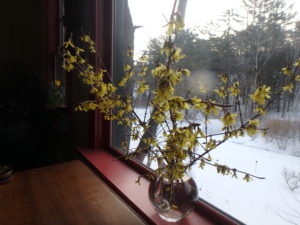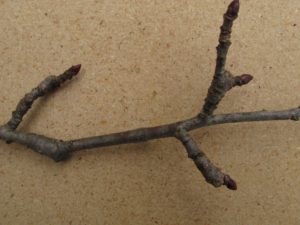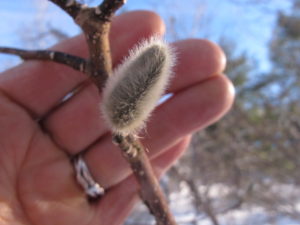Forcing Flowers on Spring-Blooming Trees and Shrubs
I recently got a new tool that I’ve been using to pick stems of forsythia and pussy willows. Stems of spring-blooming shrubs put in a vase with water will bloom earlier inside than they would outside – and I’m ready for blossoms. Often the best buds are high up where I can’t reach them without a ladder, so I was delighted to find a pole pruner that both cuts branches, and holds onto them so that I don’t have to search for them after they’re cut. It holds on, allowing me to place the branches neatly in a pile that I will bring indoors.
I got the tool from The Wildflower Seed & Tool Company (www.wildflower-seed.com or 800-456-3359) at the Philadelphia Flower Show. They come in three sizes: a 2-footer that is designed for picking roses, one that extends from 4 to 6.5-feet, and a long one that will extend from 6 to 10 feet in length. The extending pole pruners have pivoting heads. They range in price from $59 to $114 plus shipping. I have the mid-sized tool, and it did a great job helping me pick forsythia stems.
Since we are having an extended winter this year, forcing blossoms is important to my sanity. I found it only takes about a week now from the time I cut forsythia branches to the time they blossom indoors on a sunny window sill and last for about a week. Other shrubs that can be forced include apple and crabapple, magnolia, honeysuckle, quince, serviceberry (shad bush) and flowering dogwood.
My gardening grandfather grew lots of forsythia. He had a double row of them probably 50 feet long and 10 feet tall. As children, my sister Ruth Anne and I loved the forsythia because we used this huge cluster of greenery as a respite from the heat of summer – and the prying eyes of adults. In between the two rows was a vacant space, just right for kids to sit in and hide. We’d crawl inside and disappear.
Good varieties of forsythia in cold country include New Hampshire Gold, Meadowlark, Northern Gold and Vermont Sun. All those are hardy to Zone 4. There may new varieties as well.
Forsythia branches tend to flop when they get to be a certain length, and where they touch the ground they will root in, starting a new bush. Let one root for a year, sever the connection from the mother plant, and you can dig it up and plant it elsewhere. This means, of course, if you don’t prune those longer branches, your single plant will become a clump, and before long you will have a mess.
Most bush honeysuckle species are on the invasive species list. These include Lonicera bella, L. morriwii and L. tatarica. So if you have wild bush honeysuckle I encourage you to cut plenty of stems and bring them inside for forcing. The fewer flowers left on the bushes, the fewer seeds, and thus fewer new bushes spreading out over the landscape. I’ve never forced them before, but will try to find some this year. They are common alongside the road where I live.
This is the time to prune your apples and crabapples, and the stems you remove can provide you with nice flowers and foliage. But not all apple stems have flower buds. What you want are branches with fruit spurs on them. These are 2 to 4 inch-long spurs (short branches) coming off mature branches. And a fruit spur must be 2 years old or more to have blossoms.
The buds you see on an apple spur will contain anywhere from one to six flower buds, along with leaf buds. Water sprouts those vertical shoots the diameter of a pencil, do not generally have any flower buds. Fruit spurs are most common on branches that are at a 45 to 60 degree angle from the vertical.
Flower buds are always bigger than leaf buds. When choosing stems to cut, look for buds that are fat or round. When pruning blueberries, for example, I am careful not to cut off many fruit buds. The difference is obvious. Leaf buds are small and pointy, flower buds are round and plump.
Shrubs like forsythia or honeysuckle are very forgiving. You can cut stems almost anywhere, and they will recover. When cutting stems from trees like magnolia or apple, slow down and take more time. Don’t leave stubs (or short remnants of branches). Cut each branch back to the place where it joins a bigger branch, or the trunk. If you leave a stub it will not grow, and will have to rot back to the bigger branch to heal. That might allow insects or disease to enter the tree.
When deciding where to make your cuts, see if you can recognize the branch collar. That is a swollen area at the beginning of a branch, and is often wrinkled. Leave the branch collar. Never remove the branch right back to the trunk with a “flush cut.”
Right now, when warm spring weather is normally present, our shrubs like forsythia will bloom within a week indoors. And those pussy willows we all love? They are fuzzy and cute already. If you put them in a dry vase, pussy willows will stay looking cute for months. So put on your boots, and go cut some.
Read Henry’s blog at https://dailyuv.com/





